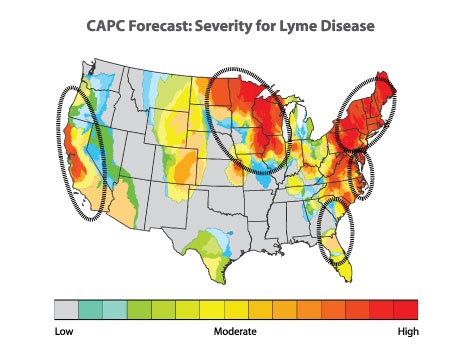Tick bites on dogs and cats. Ticks. the word alone is enough to make any pet owner shudder. These tiny, blood-sucking parasites transfer nasty illnesses like the notorious Lyme Disease: a dangerous infection that can cause everything from muscular to neurological problems in animals and humans.
Ticks were once known to hitch a ride on your dog after a hike in the woods – but with the U.S.’s growing population and ever-changing landscape, the bugs are spreading their location, too. What can you do to keep your furry friends (and yourself) safe from ticks? We’ve answered some of the top questions below.
“Are my pets at risk of a tick-bite?”
Do you live in the United States? Does your pet spend time outside? If so, then the safe answer is yes: your pet is at risk of a tick bite. Of course, there are many factors that affect the true likelihood of a tick bite, and what effect it’ll have on your pet.
One of these factors is location. Ticks can be found in virtually every county across the U.S., but are much more prevalent in areas like the Northeast and the Western coastline. If you live in a heavily wooded area or an area surrounding fresh water, you’re more susceptible than others. Ticks, especially the Lyme disease-carrying Deer Ticks, thrive in shady, moist areas, the edges of woods, and even stone walls. If you and your pet live in an apartment, you’re less at risk than someone on the edge of a pond – but tick-borne diseases can be spread by exposed animals who physically transport ticks themselves.
Spring has sprung in the United States. Above is a 2025 map developed by the Companion Animal Parasite Council to showcase the Lyme prevalence forecasted for the United States.
 Northeast On High Alert
Northeast On High Alert
You’ll notice the Northeast is the highest risk, with over 10% of counties housing ticks with disease-causing bacterium. The semi-good news is that the chilly Northeast temperatures cause tick species to lay low until warmer spring weather.
Another important factor, of course, is the species of pet you have. When we think ticks, we think dogs – but there are other pets at risk of getting hurt by a tick bite. Cats, though fortunately highly resistant to Lyme Disease, can develop other tick-related issues like Hemobartonellosis: a bacterial parasite linked to life-threatening anemia. Other domestic animals are no better off than dogs. Horses, goats, and even cows are susceptible to Lyme and other tick-related diseases. If you have chickens, though, here’s some news that’ll unruffle your feathers: chickens actually eat ticks! Perhaps it’s time to consider raising your own backyard chickens.
“What can I do to prevent a tick bite?”
It’s never bad to prevent your pet from dangerous tick bites, and there are a few options for doing so. The simplest first step to take: give your pet a full body scan after spending time outdoors. This includes checks after walks in the yard or the park, and especially after spending any time near wooded areas.
For those with grass yards, make sure to keep your grass at a low height to avoid tick hot-spots. Keep your yard free of debris, including leaf and wood piles, as these become homes for the pesky parasites.
 Spray For Ticks
Spray For Ticks
If your land borders heavy shrubbery or trees, it may be worth the extra step to have your yard sprayed. Hire a professional to apply a perimeter insecticide treatment to your yard, but first be sure that any outdoor pets and their food supplies (like hay or feed) are safely out of the way. Clean and treat any of your pet’s favorite shady hang out spots, like under decks and trees. Using cedar mulch is another great, natural way to keep ticks at bay. The wood repels ticks, and even fleas, so considering using it around your yard, under decks, and in flower beds.

Did you find this article useful? Would you like 100% free access to more articles like these, and free access to over 5,000 vetted pet care service professionals throughout the United States? Sign up here for a free Petworks account, and take 10% off your first booking, on us!
Physical Preventatives
Of course, caring for your environment is only one step to keeping your pet safe. It’s also important to arm your pet with physical preventative measures.
- Tick Prevention For Dogs: Tick collars, like these from Seresto and Sentry, are effective in repelling and killing ticks prior to biting. For a natural solution, geranium oil is safe to apply on a dog’s collar. Topical applications, like Frontline Plus, can be used on the fur to kill ticks and larvae and to prevent others for 30 days. Chewable doses, like NexGard, can be given orally for similar prevention.
- Tick Prevention For Cats: Tick collars, like one from Advantage II, will repel and kill ticks. Topical applications, like Frontline Plus, can be used on the fur to kill ticks and their larvae, and repel others for 30 days.
- Tick Prevention For Horses: Spray or wipe on insect repellant containing cypermethrin or permethrin prior to riding.
- Tick Prevention for Cattle, Sheep, Goats, and other livestock: Apply a spray-on or dust-on insecticide to prevent ticks, lice, and other pesky bugs. Many are approved for use on lactating animals, and are safe to use during milk production.
“My pet got bit! How do I remove a tick?”
Even with the best preventative measures, it’s not always easy to keep the teeny terrors away from your pets. If you find a tick on your pet, stay calm. Grab some gloves and a pair of fine point tweezers, and grab the tick as close to your pet’s skin as possible. Gently pull up with a straight, steady motion, so as not to leave the tick’s head embedded in the skin. After the tick has been removed, clean the bite-site with rubbing alcohol, then be sure to wash your hands and disinfect the tweezers.
What are post tick-bite symptoms to look out for?
If your dog, cat, or other pet has been bitten by a tick, keep an eye out for lethargy, vomiting, loss of appetite, loss of muscle movement, and rapid heart rate. These can be signs of harmful, or even deadly, infections like Tick Fever and Lyme Disease.
If your pet, particularly dog, appears to be “stuck” sleeping or in a comatose state, this is a sign of Tick Paralysis. Symptoms of tick-related illnesses can take between days and even months to appear, so if you begin to notice any unusual symptoms, visit your local veterinarian, or go to Petworks for pet care services
They’re tiny, but their impact is mighty. Don’t take the risk with ticks – start preventative measures early to keep your beloved companions safe through every season!
 In 2021, Dr. Marty Goldstein DVM joined the pet care platform Petworks as an advisor in its Animal Nutrition care division. Dr Marty Nature’s Blend is on a mission to help your pets live their healthiest lives possible. Dr. Marty’s pet nutrition expertise and guidance has helped Petworks evolve and become the preeminent animal and pet nutrition consultation service for pet parents in North America.
In 2021, Dr. Marty Goldstein DVM joined the pet care platform Petworks as an advisor in its Animal Nutrition care division. Dr Marty Nature’s Blend is on a mission to help your pets live their healthiest lives possible. Dr. Marty’s pet nutrition expertise and guidance has helped Petworks evolve and become the preeminent animal and pet nutrition consultation service for pet parents in North America.
 In 2022, Blue Buffalo Founder Bill Bishop Jr. joined Petworks as Senior Advisor in our Animal Nutrition Care Division. Bill brings his extensive expertise in pet food innovation and business leadership. His guidance helps Petworks enhance our pet nutrition service offerings, helping to ensure that pet parents throughout the world receive trusted, science-backed nutritional support for their dogs, cats, and animals.
In 2022, Blue Buffalo Founder Bill Bishop Jr. joined Petworks as Senior Advisor in our Animal Nutrition Care Division. Bill brings his extensive expertise in pet food innovation and business leadership. His guidance helps Petworks enhance our pet nutrition service offerings, helping to ensure that pet parents throughout the world receive trusted, science-backed nutritional support for their dogs, cats, and animals.



